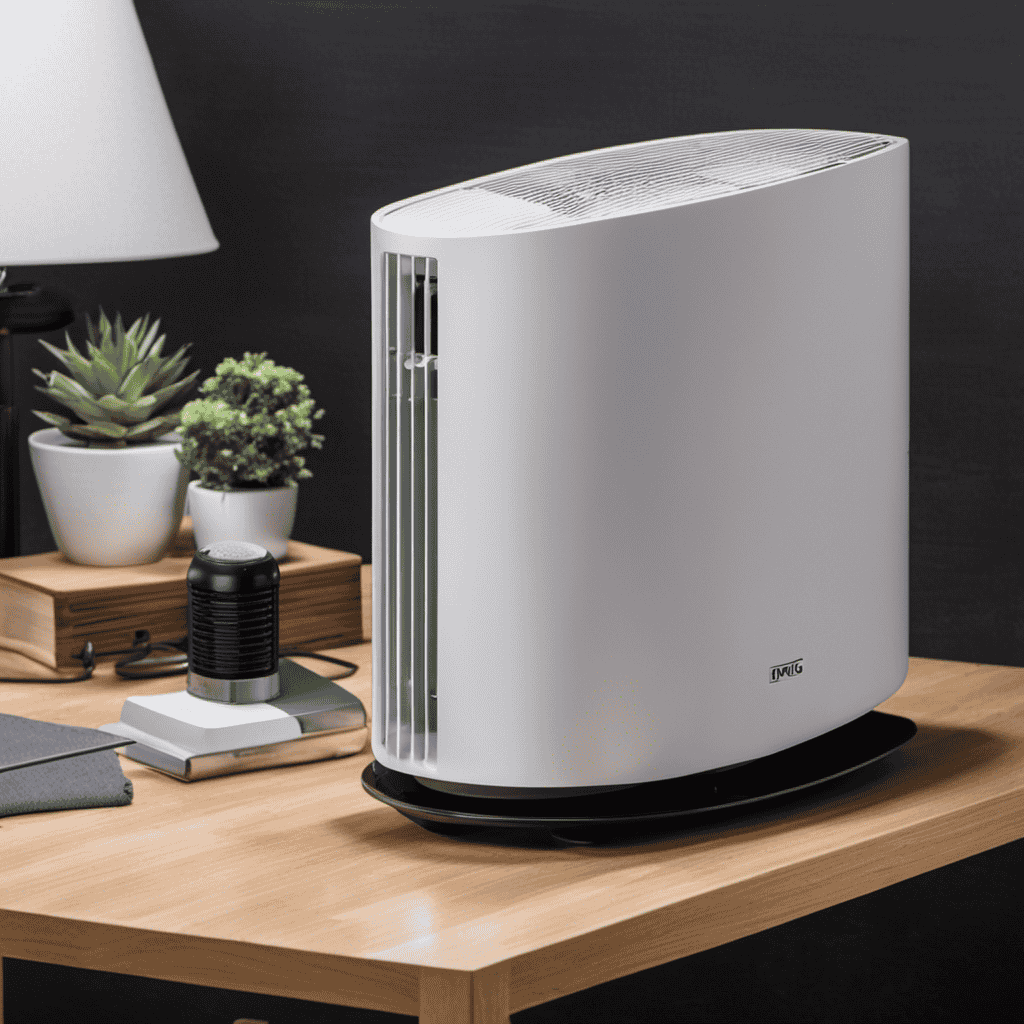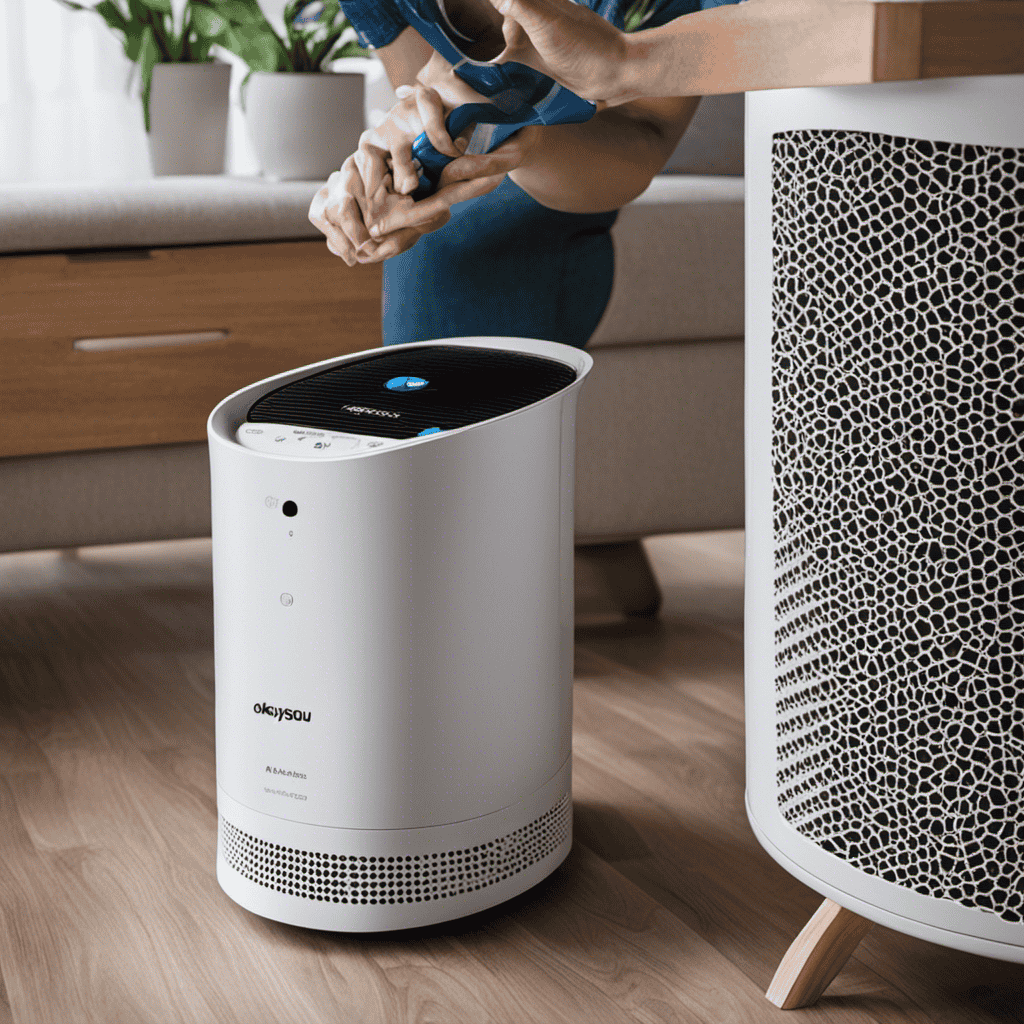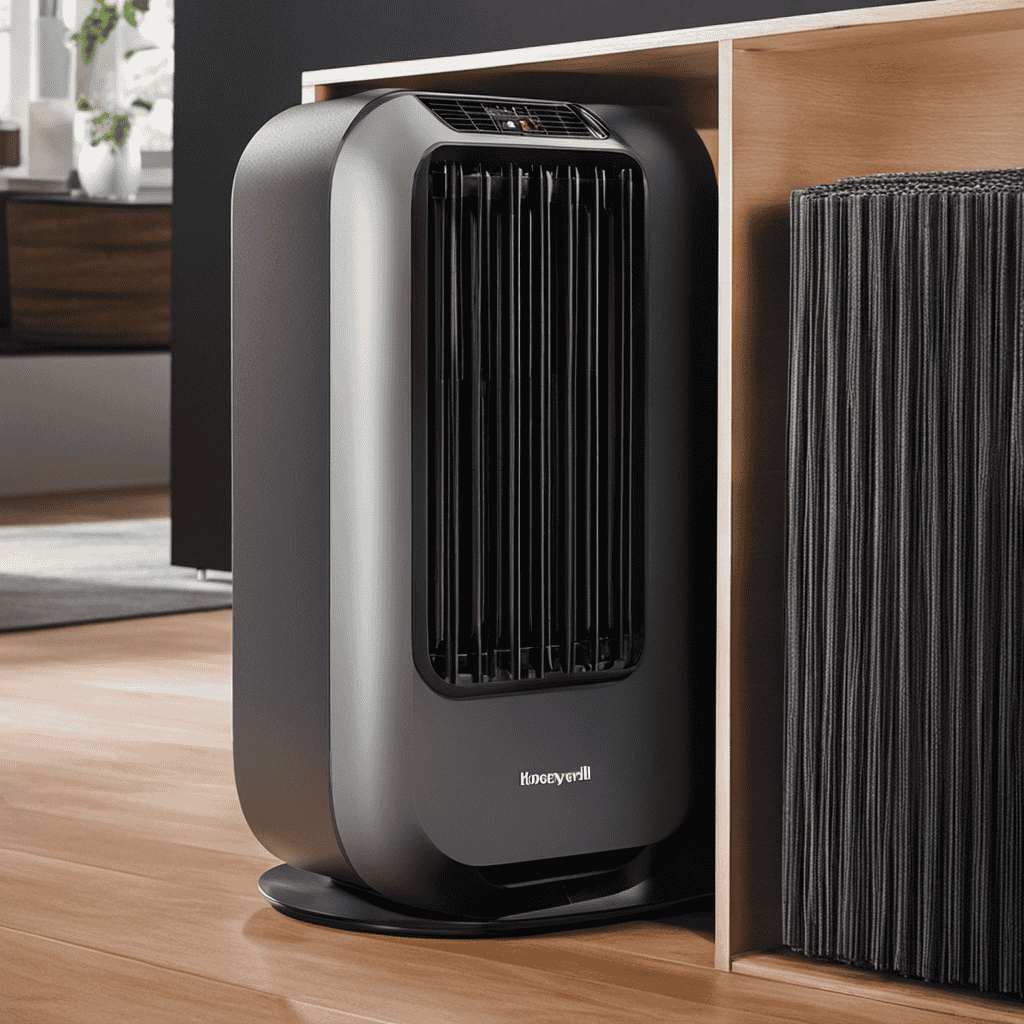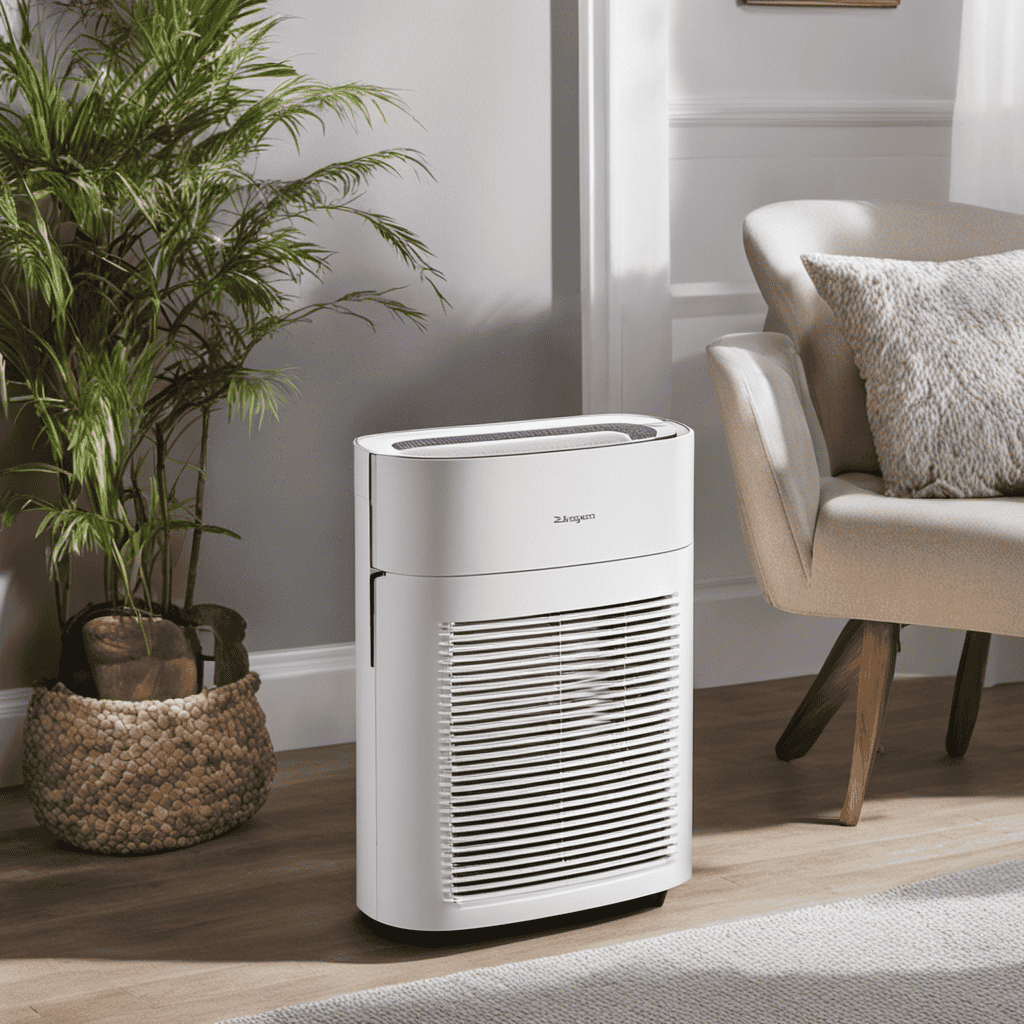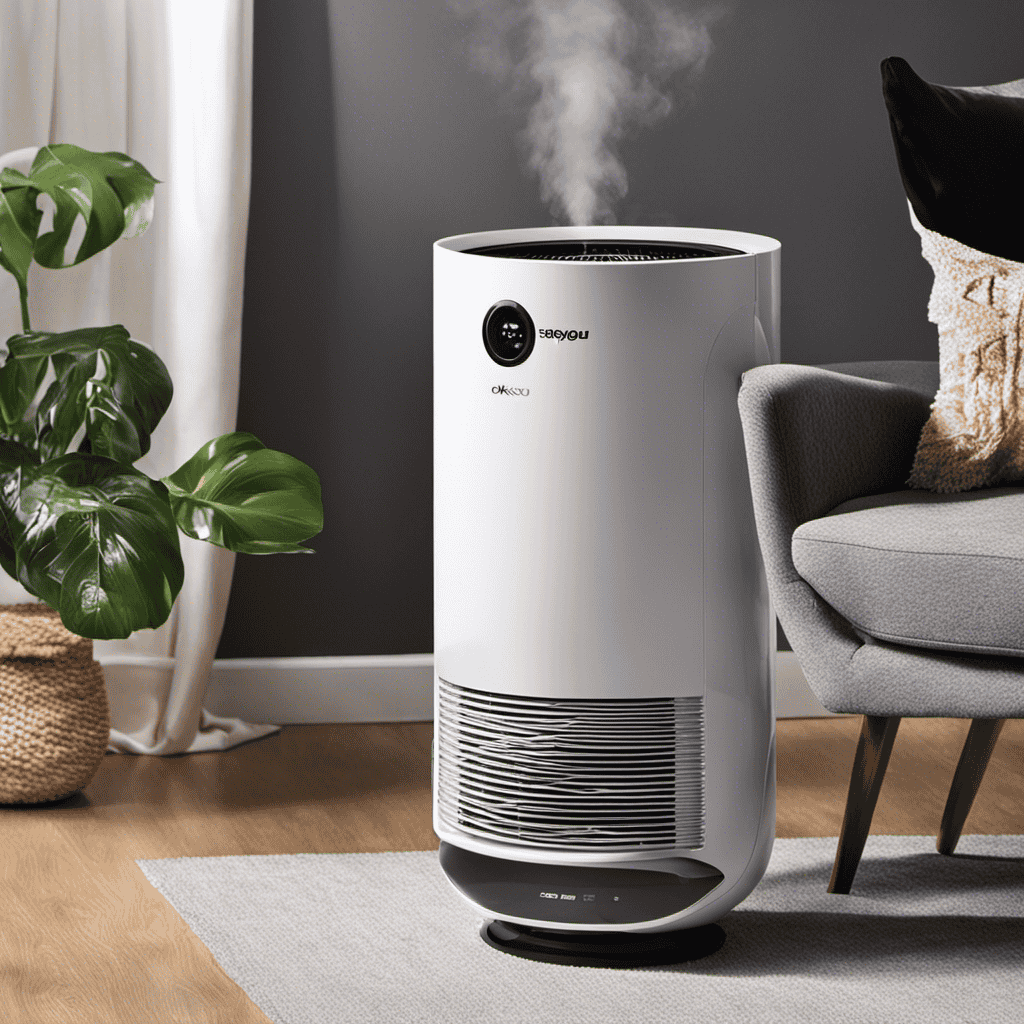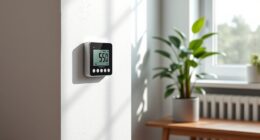So, you’ve acquired an ionic air purifier, huh? Well, consider yourself fortunate because I’m on hand to guide you through fixing it like an expert.
No need to panic when it starts acting up – I’ve got all the tips and tricks to get it back in tip-top shape. From understanding the basics to troubleshooting techniques, I’ll guide you through every step of the way.
So grab your tools and let’s get started on fixing that trusty purifier of yours.
Key Takeaways
- Regular maintenance and cleaning of the ionization mechanism is crucial for optimal performance of the ionic air purifier.
- Faulty ionization mechanisms can lead to poor air quality and potential health risks, so it is important to inspect and replace damaged or worn-out wires.
- Ineffective odor removal can indicate a problem with the purifier, and regular cleaning and replacing of parts can help resolve this issue.
- Following manufacturer’s instructions, using appropriate filters, and ensuring unobstructed airflow can improve the air quality and lifespan of the ionic air purifier.
Understanding the Basics of Ionic Air Purifiers
To understand the basics of ionic air purifiers, you’ll need to know how they work and what makes them different from other types of air purifiers.
Ionic air purifiers use a process called ionization to clean the air. They release negatively charged ions into the air, which attach to positively charged particles like dust, pollen, and pet dander. This creates an electrostatic charge that causes the particles to stick to surfaces or be attracted to the purifier’s collection plates.
Unlike other air purifiers, ionic ones don’t rely on filters and can effectively remove smaller particles from the air. To troubleshoot any issues with an ionic air purifier, it’s important to regularly clean the collection plates and ensure there are no obstructions in the air intake or outlet.
Regular maintenance tips include wiping the plates with a damp cloth, cleaning the unit’s exterior, and replacing any worn-out parts.
Now, let’s move on to identifying common issues with ionic air purifiers.
Identifying Common Issues With Ionic Air Purifiers
When it comes to identifying common issues with ionic air purifiers, two key points that often arise are a faulty ionization mechanism and ineffective odor removal.
A faulty ionization mechanism can lead to a decrease in the purifier’s ability to effectively remove pollutants from the air. This can result in poor air quality and potential health risks.
On the other hand, ineffective odor removal can be a major concern for users. Lingering smells can be unpleasant and may indicate that the purifier is not effectively eliminating odors from the air.
Fortunately, these issues can typically be addressed through proper maintenance and troubleshooting techniques. Regularly cleaning and replacing the ionization mechanism can help ensure its proper functioning. Additionally, using appropriate filters and following the manufacturer’s instructions for odor removal can help improve overall air quality.
Faulty Ionization Mechanism
If your ionic air purifier’s ionization mechanism is faulty, you may notice a decrease in its effectiveness. To ensure optimal performance, regular ionization maintenance is essential.
Start by inspecting the ionization wires for any signs of damage or corrosion. Clean them gently using a soft brush or cloth to remove any dirt or debris. If the wires are broken or worn out, they may need to be replaced.
Additionally, check the power supply and electrical connections to ensure they are secure. If the issue persists, try resetting the purifier to its factory settings.
If none of these troubleshooting techniques solve the problem, it may be necessary to contact a professional technician for further assistance. Remember, proper maintenance and timely repairs are crucial for your air purifier to function effectively.
Ineffective Odor Removal
Regular maintenance and cleaning are essential to ensure your purifier effectively removes odors. However, if you find that your ionic air purifier is not effectively removing odors, there are a few troubleshooting techniques you can try.
First, check if the purifier’s filters are dirty or clogged, as this can hinder its odor removal capabilities. Clean or replace the filters if necessary.
Additionally, ensure that the purifier is placed in the right location, away from any obstructions that may hinder airflow.
If these steps do not resolve the issue, you may need to consider contacting a professional for further assistance.
In the next section, we will discuss the tools needed for repairing ionic air purifiers, which can help you address any underlying issues that may be causing ineffective odor removal.
Tools Needed for Repairing Ionic Air Purifiers
You’ll need some tools to repair ionic air purifiers. When it comes to repairing these devices, there are a few essential tools that you should have on hand.
Firstly, a multimeter is crucial for troubleshooting and testing the electrical components of the air purifier. It allows you to check for continuity, voltage, and resistance.
Additionally, a set of precision screwdrivers will be useful for removing screws and accessing the inner components of the purifier.
Needle-nose pliers can come in handy for bending or straightening small wires and connectors.
Finally, a soldering iron and solder are required for repairing any damaged electrical connections.
With these tools, you’ll be well-equipped to tackle common repair techniques and troubleshooting tips for ionic air purifiers.
Now that you know the essential tools needed for repairing ionic air purifiers, let’s move on to explore some troubleshooting techniques for these devices.
Troubleshooting Techniques for Ionic Air Purifiers
When it comes to troubleshooting and repairing ionic air purifiers, there are some common steps that I always follow.
These steps include checking the power supply, inspecting the filters, and examining the fan or motor.
In addition to these troubleshooting steps, I have also found some effective repair methods that have proven to be successful in fixing common issues with ionic air purifiers.
Common Troubleshooting Steps
If your ionic air purifier is not working properly, start by checking the power cord for any damage or loose connections. This is a common issue that can easily be resolved by replacing the cord or tightening the connections. However, if the power cord is in good condition, there may be other troubleshooting techniques you can try. Refer to the table below for some common issues and their corresponding solutions:
| Common Issue | Solution |
|---|---|
| No power | Check power source |
| Weak airflow | Clean or replace filters |
| Strange odor | Clean or replace filters, check for mold or mildew |
Effective Repair Methods
To effectively fix any issues with your ionic air purifier, start by performing basic troubleshooting steps. Once you have identified the problem, here are some repair techniques and DIY solutions that you can try:
- Clean the ionizing wires or plates using a soft brush or cloth to remove any dust or debris buildup.
- Check the power supply and ensure that the unit is properly plugged in.
- Inspect the filters and replace them if necessary.
- Reset the purifier by turning it off and unplugging it for a few minutes before plugging it back in.
- If the issue persists, consult the manufacturer’s manual or contact customer support for further assistance.
Step-by-Step Guide to Cleaning Ionic Air Purifiers
First, you’ll need to gather all the necessary supplies for cleaning your ionic air purifier. Here are the cleaning techniques and maintenance tips that I recommend:
| Supplies Needed | Cleaning Technique | Maintenance Tip |
|---|---|---|
| Microfiber cloth | Wipe the exterior surfaces of the purifier to remove dust and dirt. | Clean the cloth regularly to prevent the spread of contaminants. |
| Compressed air can | Use the can to blow away dust from the air intake vents and the ionizing wires. | Ensure proper ventilation during use to prevent inhaling the compressed air. |
| Mild detergent | Mix a small amount of detergent with water and use it to clean the collector plates. Rinse thoroughly and let them dry before reassembling. | Avoid using harsh chemicals that can damage the plates. |
Replacing Parts in Ionic Air Purifiers
After cleaning my ionic air purifier following the step-by-step guide, I realized that some parts were beyond repair. It was time to replace them to ensure the optimal functioning of the device.
Here are the steps I took to replace the parts:
-
Identify the parts: I carefully examined the purifier to locate the filters and other replaceable components.
-
Purchase the replacements: I researched and found the appropriate filters for my specific model and ordered them online.
-
Turn off the device: Before replacing any parts, I made sure to switch off the purifier and unplug it from the power source.
-
Remove the old parts: Following the user manual, I removed the old filters and other worn-out components.
-
Install the new parts: I carefully installed the new filters and other parts, making sure they fit securely in place.
Maintaining and Preventing Future Issues With Ionic Air Purifiers
In order to prevent future issues with my device, I regularly clean and replace the necessary parts. One of the main concerns when maintaining an ionic air purifier is preventing mold growth and reducing allergens in the air. To achieve this, I follow a strict cleaning routine and replace filters as needed. Here is a table summarizing the necessary maintenance tasks:
| Maintenance Task | Frequency |
|---|---|
| Clean the plates | Every 2 weeks |
| Replace the filter | Every 3-6 months |
| Clean the exterior | Monthly |
Tips for Extending the Lifespan of Ionic Air Purifiers
To extend the lifespan of your ionic air purifier, regularly cleaning and replacing necessary parts is crucial. Here are some maintenance techniques that can help you keep your air purifier in top condition:
-
Clean the collector plates: Regularly clean the collector plates to remove any accumulated dust and particles. This will ensure optimal performance and prevent clogging.
-
Replace the filters: Check the manufacturer’s guidelines to determine the recommended frequency for replacing the filters. This will help maintain the effectiveness of your air purifier.
-
Clean the exterior: Wipe down the exterior of the air purifier with a soft cloth to remove any dust or dirt. This will keep it looking clean and prevent any buildup.
-
Keep the air purifier in a well-ventilated area: Ensure that the air purifier has enough space around it for proper airflow. This will prevent overheating and prolong its lifespan.
-
Use the air purifier in accordance with its intended purpose: Follow the manufacturer’s instructions and avoid using the air purifier in environments with excessive humidity or temperature extremes.
By following these maintenance techniques, you can extend the lifespan of your ionic air purifier and ensure that it continues to provide clean and fresh air for years to come.
Now, let’s move on to expert advice for DIY repair of ionic air purifiers.
Expert Advice for DIY Repair of Ionic Air Purifiers
If you’re experiencing issues with your ionic air purifier, one option is to seek expert advice for DIY repairs.
Diagnosing problems with an ionic air purifier can be challenging, but with the right knowledge, it is possible to fix some common issues on your own.
Before attempting any repairs, it is important to take safety precautions to avoid electrical shocks or further damage to the unit. Make sure to unplug the purifier before starting any work and wear protective gear, such as gloves and safety glasses.
When diagnosing problems, check for loose wires, clogged filters, or malfunctioning components. It is also helpful to refer to the manufacturer’s manual or online resources for troubleshooting tips.
If the issue persists or seems complex, it is advisable to consult a professional for assistance.
Frequently Asked Questions
Can I Repair My Ionic Air Purifier if It’s Still Under Warranty?
Yes, if my ionic air purifier is still under warranty, I can repair it. I would start by troubleshooting the issue and then contacting the manufacturer or authorized service center for assistance.
How Often Should I Clean My Ionic Air Purifier?
Cleaning my ionic air purifier regularly is crucial for its proper maintenance. To troubleshoot common issues, I should follow the manufacturer’s guidelines and clean the filters, plates, and exterior surfaces as recommended.
Can I Use Any Type of Cleaning Solution to Clean My Ionic Air Purifier?
No, it is not recommended to use any type of cleaning solution on an ionic air purifier. It is best to follow the manufacturer’s instructions for cleaning and consider alternative cleaning methods if needed.
Is It Safe to Use My Ionic Air Purifier While It’s Being Repaired?
It is not safe to use an ionic air purifier while it’s being repaired. It is important to follow proper air purifier maintenance procedures to address common issues and ensure optimal performance.
Are There Any Specific Safety Precautions I Should Take When Repairing My Ionic Air Purifier?
When repairing my ionic air purifier, I always take safety precautions to ensure I don’t get injured or damage the device further. It’s important to be aware of common repair issues and follow proper procedures.
Conclusion
In conclusion, repairing an ionic air purifier can be a straightforward process with the right knowledge and tools. By understanding the basics of these devices and identifying common issues, you can troubleshoot and clean them effectively.
Replacing parts when necessary and maintaining the purifiers regularly will help prevent future problems and extend their lifespan.
As the saying goes, ‘A stitch in time saves nine,’ taking prompt action to repair your ionic air purifier will ensure clean and fresh air for years to come.
